What is the difference between greenhouses and greenhouses?

Every summer resident dreams not only of increasing the productivity of plants, but also of growing especially heat-loving varieties. Then you need to decide what is more profitable and more efficient to use, a greenhouse or a greenhouse, and what is the significant difference between them.
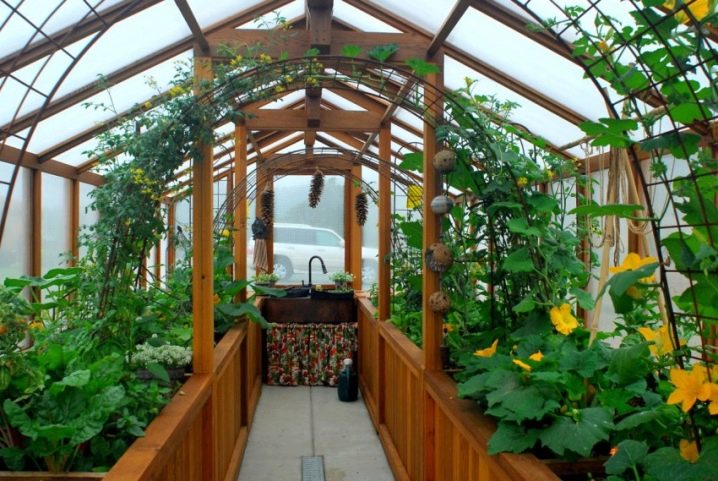
Features of greenhouses and greenhouses
In simple terms, greenhouses are a simplified version of a greenhouse. The height of the first structures covered with glass or foil is only about half a meter. In greenhouses, warm air inside is formed not only from the sun, but also from the decay of manure and other organic fertilizers, since the seedlings are necessarily planted with their use.
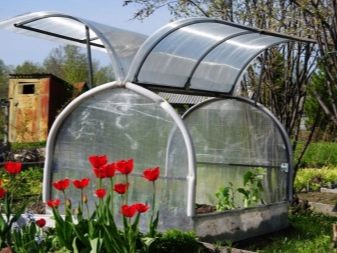
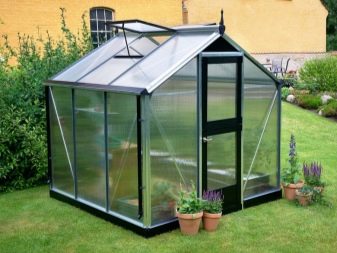
The first greenhouses were organized like greenhouses and were intended exclusively for the cultivation of rare species of exotic plants. It is known that glass greenhouses existed in France as early as the 16th century. In modern versions of greenhouses, not only ordinary polyethylene film is increasingly used for covering, but also such innovative materials as cellular polycarbonate. Therefore, modern structures have become lighter, but at the same time they remain no less durable.
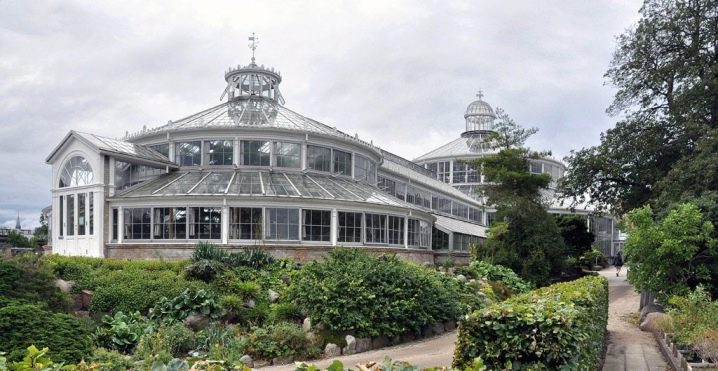
Similarity
The main similarity between greenhouses and greenhouses lies in the principle of operation of the structure, when it is necessary to protect crops from negative external influences and provide them with an optimal temperature regime. At the same time, according to the growing method, greenhouses can be hydroponic systems (suitable for lettuce, green onions, parsley, dill) or soil systems that are used for cabbage and tomatoes.



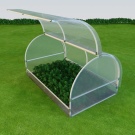
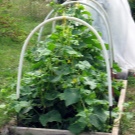

Differences
There are the main differences and nuances of greenhouses and greenhouses.
- The greenhouse is a compact design and the optimal greenhouse height is 2–2.5 meters.
- The simplified design of the greenhouse allows you to plan beds exclusively on the ground. While in the greenhouse, you can show your imagination and use various elements to use techniques such as beds on shelves or hydroponics.
- The greenhouse will last only one season, and next year this temporary structure will have to be erected again. The greenhouse is more monumental and durable, you only have to correct the flaws of its design from time to time, for example, change the cover.
- In greenhouses, plants are heated exclusively by the sun, as well as the use of humus and manure, and in improved greenhouses, options such as artificial heating and a system that controls soil and air moisture, a complex ventilation and air conditioning system and many other nuances can operate. get the maximum yield.
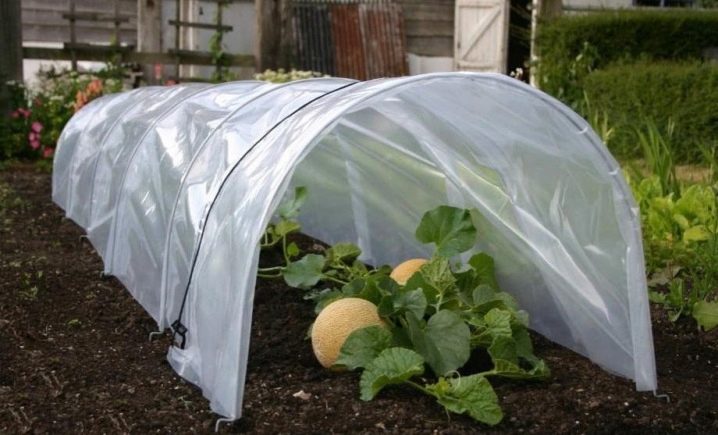
- There are no doors in the greenhouse. To manipulate plants, just open its top or side. The greenhouse has both doors and windows (vents) for additional ventilation.
- Greenhouses can be transported or moved around the site, as they are portable, while the greenhouse is a stationary structure.
- As a rule, greenhouses are used for seedlings in the spring and for temporary shelter of some crops during frosts, and in the greenhouse it is possible to cultivate plants all year round due to the possibility of heating the room.
- You can stay in the greenhouse design at any time of the year and in any weather. When working with a greenhouse, you will need to be outside, which means that you will hardly be able to work in the rain.
- In a greenhouse, you can only grow seedlings or unpretentious plants, for example, onions, lettuce or radishes. And in a greenhouse, you can provide the necessary microclimate for almost any, even a very thermophilic plant.
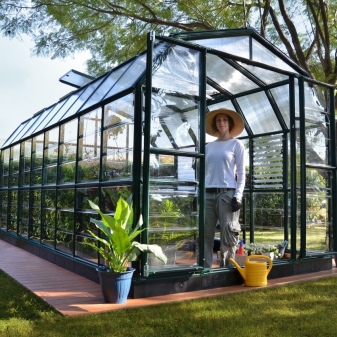

Manufacturing materials
For the construction of such a stable and strong structure as a greenhouse, steel, aluminum, glass, honeycomb (cellular) polycarbonate, polyethylene film are used. However, a large greenhouse may require a solid foundation. An aluminum or galvanized profile is usually used as a greenhouse frame., and if there is a desire to build a wooden base, then it must be treated with special antiseptics against the influence of external factors.
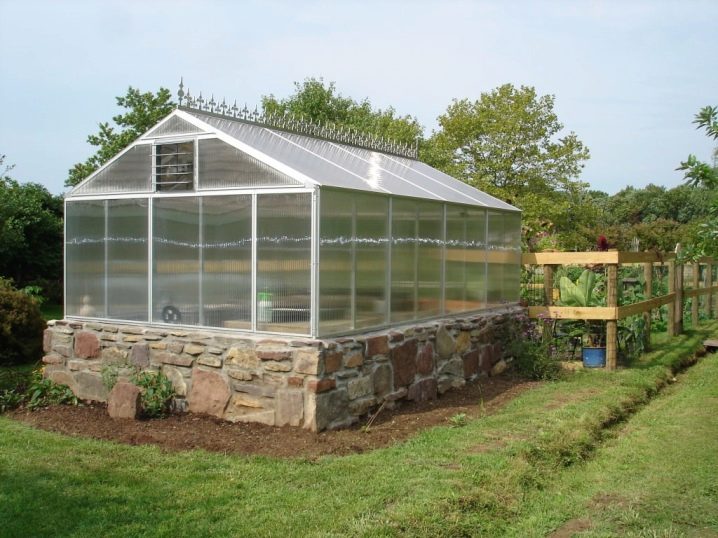
When choosing a greenhouse cover, you need to understand that the film is a popular, but, unfortunately, quite short-lived option from the “cheap and cheerful” series. And the thermal insulation in such a greenhouse leaves much to be desired. If finances allow, then it is better to opt for glass that perfectly transmits light and does not give off heat. At the same time, glass is suitable only for single-slope and gable types of greenhouses.
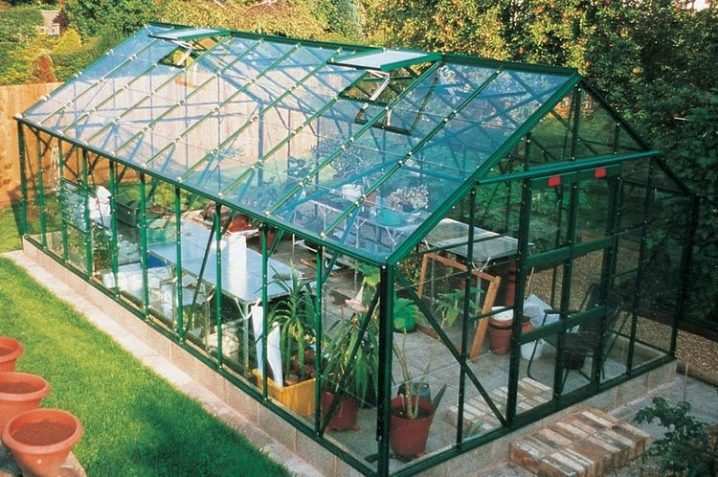
The most reliable coating material is cellular polycarbonate. It is multi-layered, durable, perfectly retains heat and at the same time allows a lot of light to pass through. Thanks to the air in the space between the "honeycombs", heat is retained inside. It is often used by summer residents due to its affordable cost and good frost resistance (it can withstand frost down to -50 degrees Celsius). In addition, it is easy to handle and bends well, as well as durable (the warranty period for using such a material is 20 years). This is a great option for those who live in the northern regions. For classic types of greenhouses, it is worth choosing polycarbonate with a thickness of 4 or 6 mm.
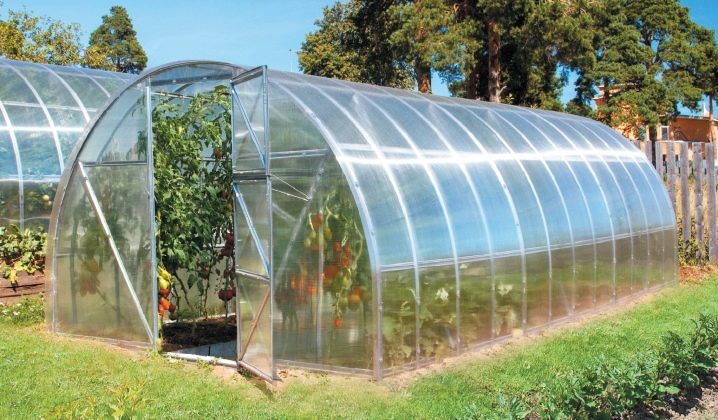
There are many differences between polyethylene films:
- For a snowy winter, it is worth choosing a reinforced film.
- The highest light transmittance is in ordinary film, but it is fragile, therefore it is suitable for structures "for one season".
- The stabilized foil with anti-fog is ideal for seedlings and does not form condensation underneath.
- The light scattering film reflects intense ultraviolet and infrared rays, thereby protecting plants from excessive sun exposure.

The most durable of the films is copolymer, since it withstands any gusts of wind and is frost-resistant, since it does not crack even down to -80 ° C, so it is chosen for harsh climates. The foamed film retains heat well, but has a low light transmittance. This option is suitable for southern regions where there are many sunny days a year.

Semi-automated greenhouses are equipped with a drip irrigation system and automated moisture maintenance. And in manual designs, everything is done the old fashioned way, but with a soul. But physical strength will also have to be spent a lot. Additional functions also include air conditioning, temperature control and ventilation. In this case, the role of "controller" can be performed by a computer in which all modes are programmed. And for additional heating it is worth purchasing electric, water or steam heaters.

Types of structures
You can build a greenhouse quickly. This does not require special construction skills. You will need an arched frame with a removable roof. To cover the greenhouse, it is quite enough with ordinary plastic wrap, because this is a "one season" construction. Glass and polycarbonate are less commonly used due to their higher cost.
There are many varieties of greenhouse and greenhouse designs. It is worth paying attention to the most popular options from Russian manufacturers. The dimensions of all greenhouses are usually small, their height does not exceed 1.5 meters. The main types of greenhouse structures are covering and "butterfly".The advantage of the first option is mobility, and the feature of the second is the possibility of installation from window frames.
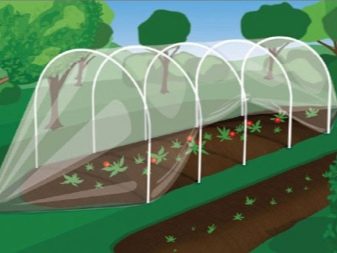
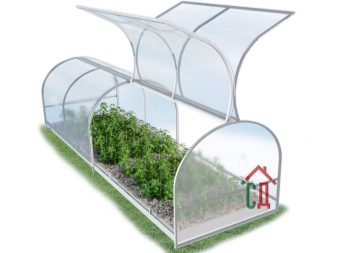
A greenhouse is quite capable of making each of the scrap materials available in the country. And you can cover it with both ordinary plastic wrap and glass from old frames. Greenhouses do not have doors or heating like greenhouses. Heating here is carried out exclusively by the sun's rays, as well as organic fertilizers such as manure or compost.
In the absence of free time and the availability of financial resources, you can order a ready-made improved design of the greenhouse "Otlichnik".
Its advantage is its convenient dimensions (width is 1.15 m, height - 1.15 m, length - from 4.2 to 5.6 m) and an affordable price from 1400 to 1700 rubles (as of 2018). Modern technologies for the production of such greenhouses can significantly increase their durability, practicality, strength and functionality.
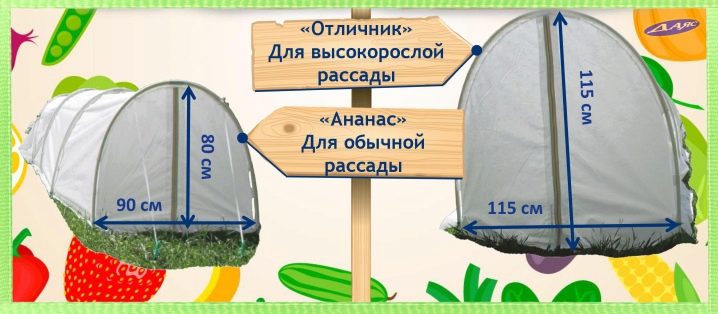
The "Excellent" model is a frame made of plastic arches with sewn-in roofing material and ribbons stretched to the arcs, which help to prevent the covering from sagging. Another handy detail is the doors with zippers at both ends, so that the seedlings can be ventilated from time to time. In this case, it is enough to throw the "doors" on the arches - and there are no difficulties, unlike conventional structures, when you have to lift all the material.
Reifenhauser SSS 60 is used as a covering material for the "Excellent" model, whose strength and durability are at a height. And if bad weather happens with a lot of precipitation or strong gusts of wind, you can be sure that such a greenhouse will pass this test with dignity. And all thanks to the channels of the "sleeve" type in the arches of the frame. They do not wear out for a long time, as they are made of durable material, which increases the service life of such a structure.
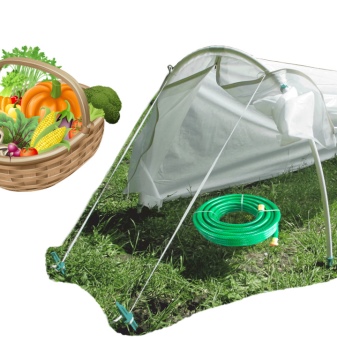
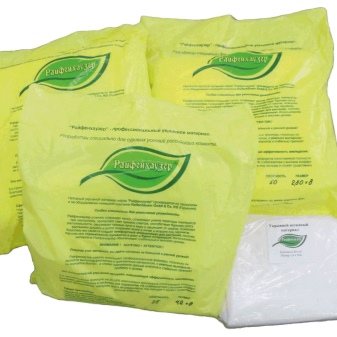
If we talk about greenhouses, then they provide even more options for choosing a design, which can be stationary or collapsible. In this case, as a rule, the customer determines what shape or configuration the greenhouse will be.
To find the ideal and durable option for a certain area and for those plants that have a desire to cultivate, it is worth considering not only the shape, material and degree of light transmission of the structure, but also many other subtleties and nuances.
Greenhouse shapes can be as follows:
- single-pitch and gable;
- arched;
- with vertical or inclined walls;
- polygonal;
- domed.

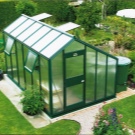
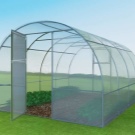
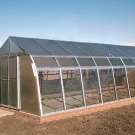
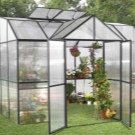
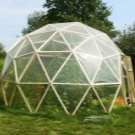
The most popular type is arched shape, since a layer of snow cannot harm such a coating. Such greenhouses are resistant to winds, and installation is as simple as possible, while you can always extend them in length.
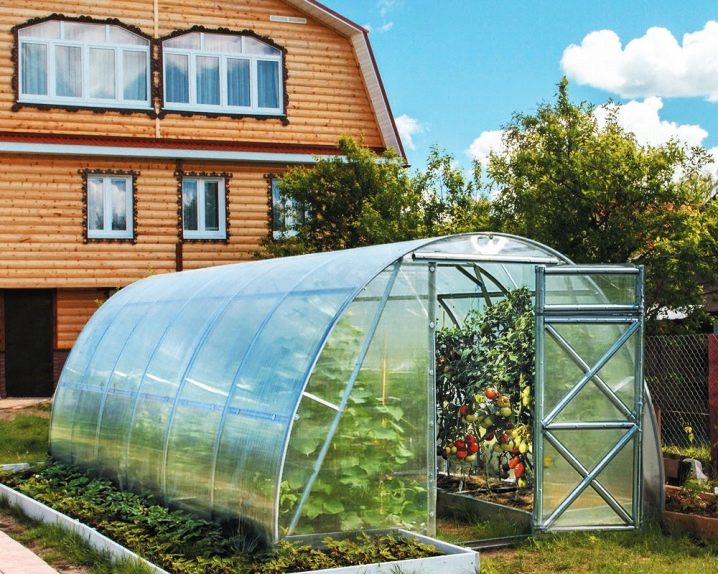
Another traditional and versatile form of a "house" greenhouse is gable... In this case, the walls can be both at right angles to the ground, and at a blunt one.
The advantages of the "house" design are many, such as:
- ease of installation;
- the ability to use "handy material" for the frame, which is available in every summer cottage, for example, wooden blocks;
- the ability to use any type of roofing material;
- you can choose the angle of the slopes and the height of the ridge;
- no snow protection is needed, as precipitation naturally descends from the roof.
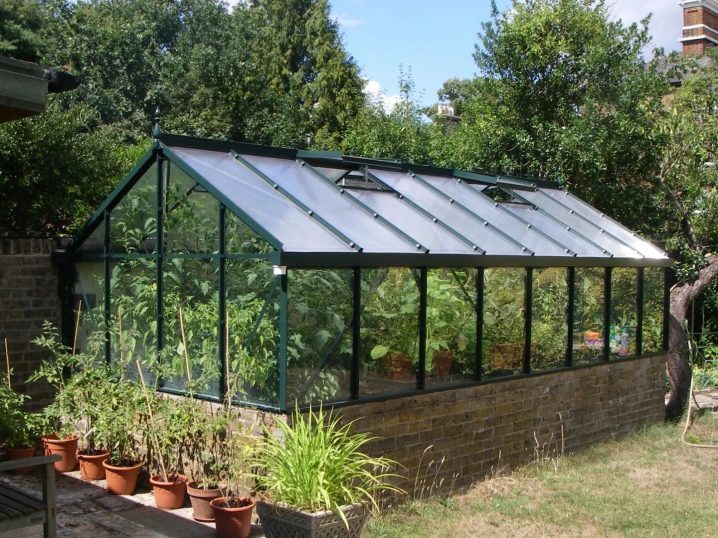
It should be borne in mind that in this design there are many connections in the frame and skin. In order for the roof to be as tight as possible, it is worth using cellular polycarbonate with a thickness of more than 6 mm as a covering.
A very original form is dome, resembling a hemisphere, where many segments of various geometric shapes are used, which ensures an even distribution of the load on the frame and, accordingly, its maximum strength. That is why even heavy-weight glass is suitable for cladding. These structures are not afraid of either wind or numerous precipitations.Due to the high stability of the structure, they are proposed to be used for earthquake-prone areas.
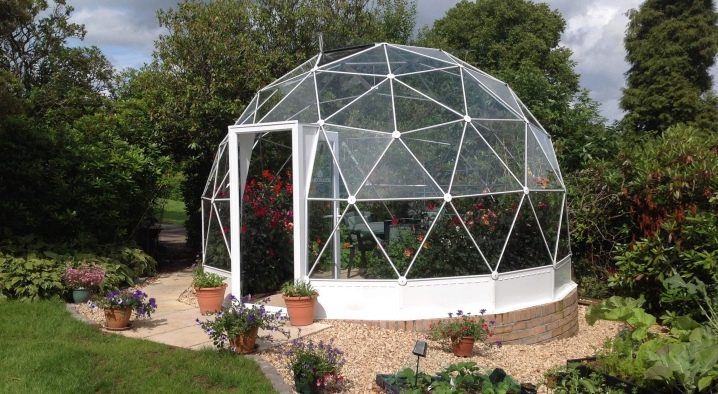
Single slope greenhouses, in fact, are outbuildings, because they can be placed next to any building, for example, a warehouse or a summer kitchen. Unfortunately, only one-sided illumination is available here. Therefore, this type of greenhouse is suitable for shade-loving plants.
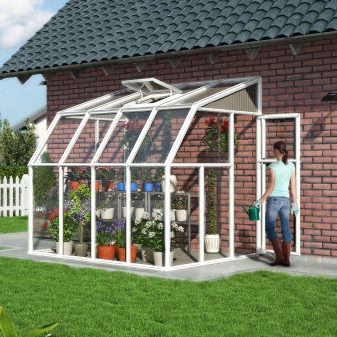
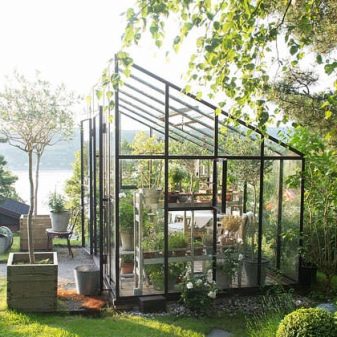
Greenhouse frames are usually made of steel or aluminum. When choosing a material for the frame, it is necessary to pay attention to whether the steel frames have a protective coating. It is this that extends the life of the suburban structure and protects it from rust. In some greenhouses, the frame is additionally coated with powder paints. In addition, steel structures for summer cottages will cost almost two times cheaper than aluminum ones.

For an aluminum base, an important rule is that the material is anodized - this means that there must be a special moisture-resistant film on the metal surface. The only drawback of a lightweight aluminum frame is the inability to use heavy types of coverings, as well as the likelihood that snow, wind and other atmospheric precipitation in winter can deform the aluminum struts.
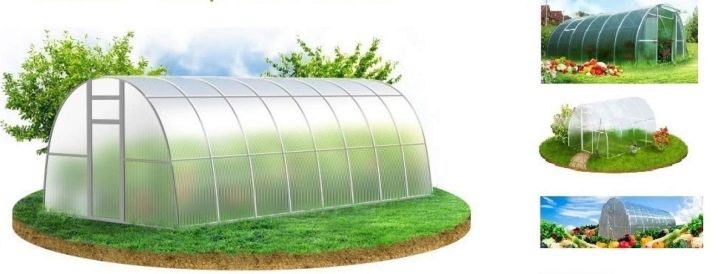
What to choose?
Given the similarities, features, and also how the various designs differ, the choice can be made only after assessing the personal requirements for the crop and, of course, financial capabilities. The weather conditions of a particular area are also important in choosing a structure for growing vegetables and flowers.
To determine the need for an expensive and complex greenhouse or a simple greenhouse for one season, it is important to know what exactly it will be built for:
- For seedlings or sheltering seedlings from bad weather, a mobile greenhouse or an easy-to-use "butterfly" design from window frames is suitable.
- If you want to get a rich harvest of heat-loving crops such as peppers or tomatoes, you need to rely on a stationary greenhouse with a reliable frame and concrete foundation. It must be equipped with a heating system and other additional functions.
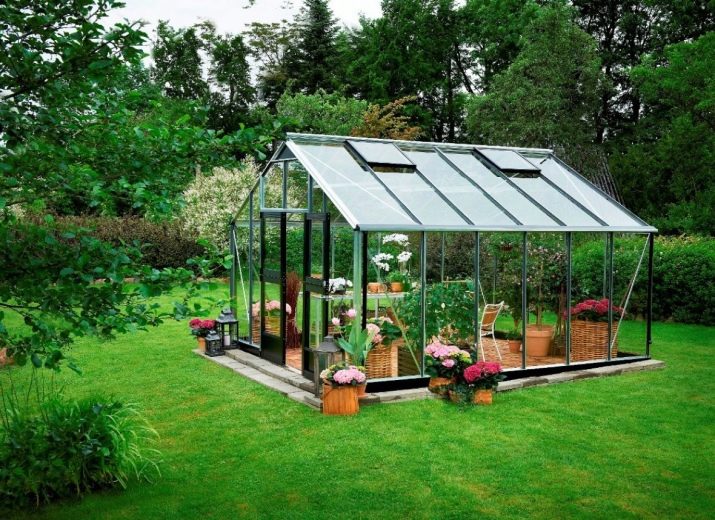
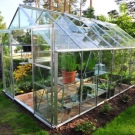
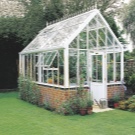
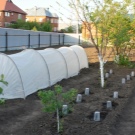
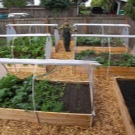

Recommendations
Expert advice will help give the greenhouse durability and excellent wear resistance, therefore you should adhere to the following valuable recommendations:
- so that condensation does not form inside the greenhouse, the seams of the structure should be reliably sealed;
- if the plans are to create a structure with a height of more than 2 meters, then it is necessary to provide it with additional support with the help of reinforcing beams;
- the most important criterion when building your own greenhouse is to make it as convenient and functional as possible in order to minimize labor costs. For this it is recommended to use "smart" systems of irrigation, ventilation and heating;
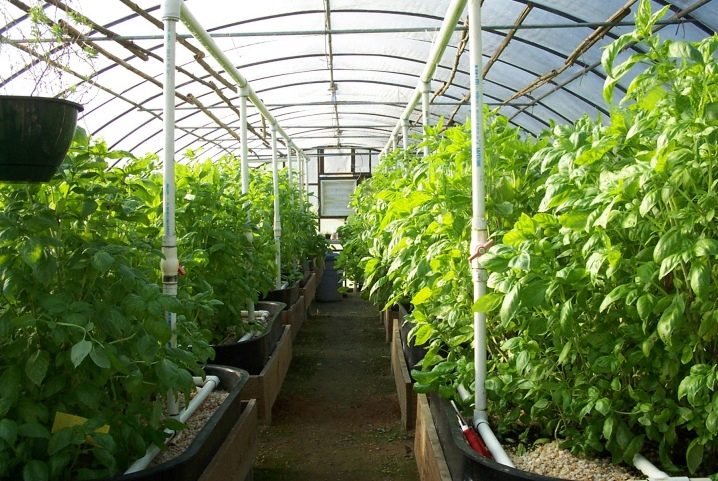
- the type of frame and the design of the greenhouse must be selected based on the climatic features of the area (more durable and resistant steel options are suitable for snowy regions, and light aluminum structures - where there is little snow);
- if the greenhouse is needed exclusively in the warm season, then it makes sense to make its structure collapsible;
- if a homemade frame is made of wooden blocks, then they need to be covered with a special moisture and bioprotective solution;
- if the greenhouse is small, then the foundation is not needed - you can install the structure on the ground.
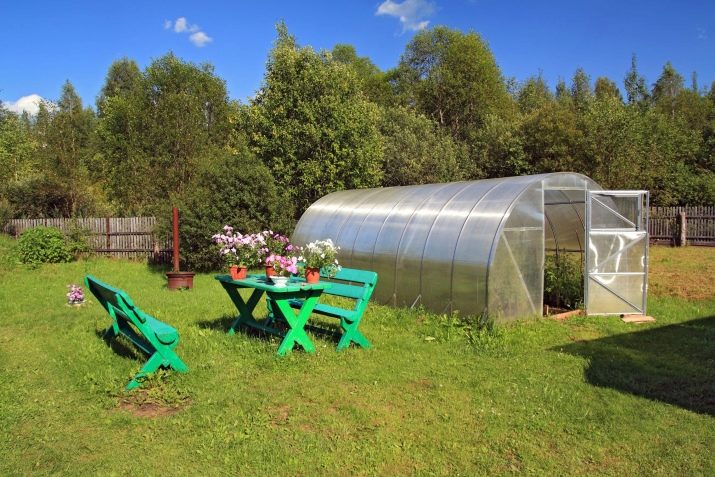
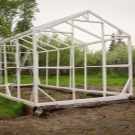
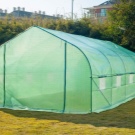
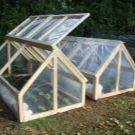
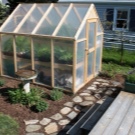
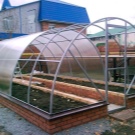
The price depends not only on the quality of materials, but also on the type of coating and frame, as well as additional functions such as the presence of windows and doors for ventilation. Greenhouses made of polycarbonate are considered to be of the highest quality, and polyethylene coated greenhouses are considered the least practical and short-lived. A cheap option is a small greenhouse with a steel frame and plastic sheeting. The most expensive ones are glass greenhouses, but they are far from the most practical.And options from steel and polycarbonate can be called affordable and at the same time reliable and durable.

Which frame for the greenhouse to choose is described in the video.





























































The comment was sent successfully.